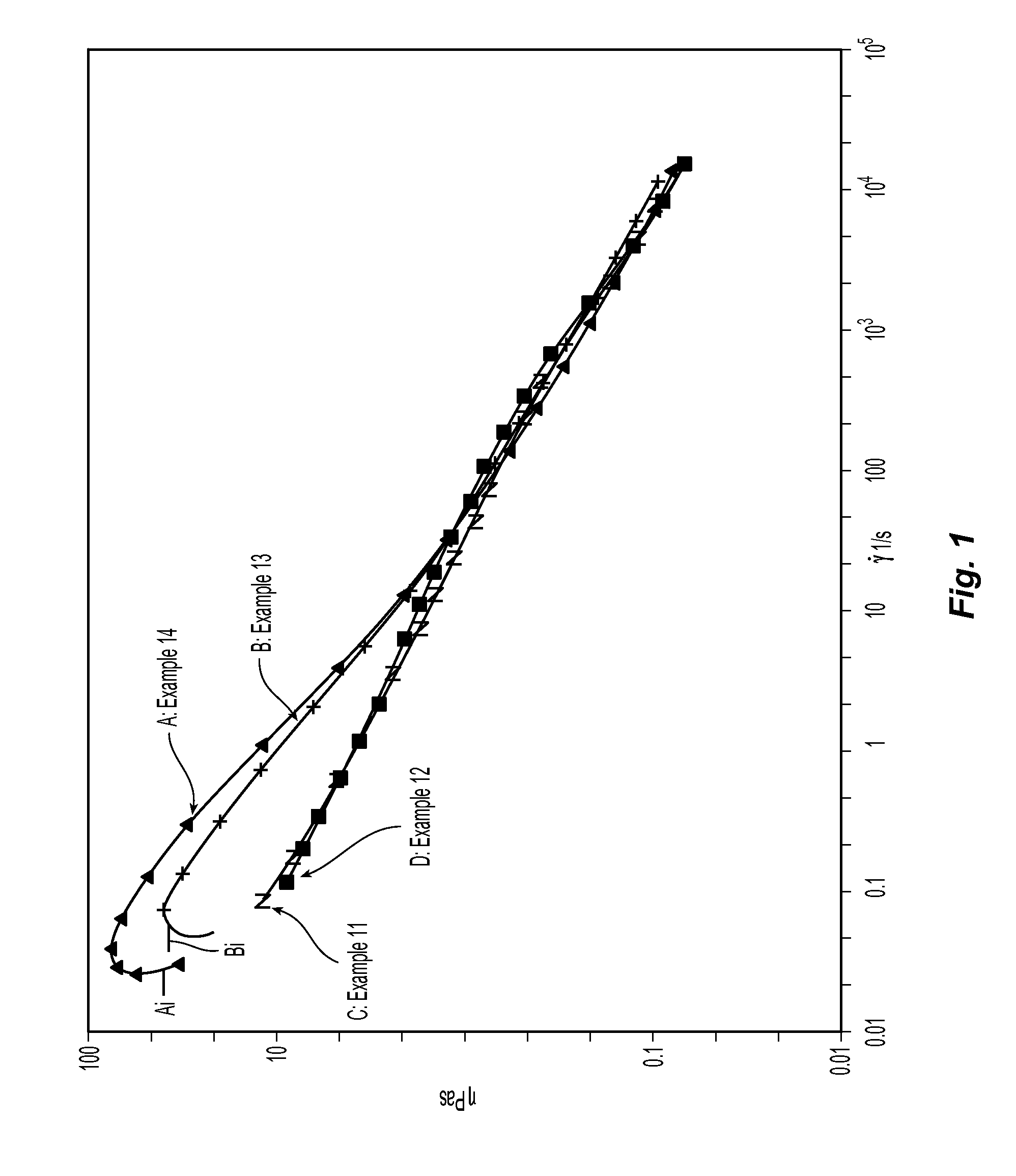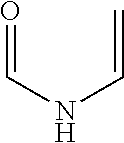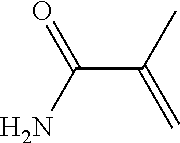Hydroxyethyl Cellulose Grafted Acrylic Latex
a technology of acrylic latex and hydroxyethylcellulose, which is applied in the direction of coatings, etc., can solve the problems of inability to graft easily to hec under, lack of mechanical stability of latexes prepared by emulsion polymerization of vinyl acetate or other vinyl esters and hec, and inability to bind to hec under, so as to prevent latex from undesired gelling
- Summary
- Abstract
- Description
- Claims
- Application Information
AI Technical Summary
Benefits of technology
Problems solved by technology
Method used
Image
Examples
example 1
[0043]To a 5-liter 4-necked round bottom glass reactor equipped with a mechanical stirrer, thermocouple, condenser, and nitrogen purge, 888.7 g of deionized (DI) water, and 4.60 g of hydroxyethyl cellulose (DOW Chemicals, WP-09H) were added and agitated for at least 20 minutes or more at 40° C.-50° C. to form a clear aqueous solution.
[0044]6.6 g of methacrylic acid monomer was added into 255.08; of DI water and 5.8 g of ammonium hydroxide (28%) was added to neutralize the solution and to bring pH to about 8.0-9.0.
[0045]The components in the following table were added into the above solution and agitated for 20-30 minutes to form monomer emulsion.
Sodium dioctyl sulfosuccinate surfactant (Aerosol OT-75)8.1gSodium dodecylbenzosulfonate (branched) surfactant2.8gMethyl methacrylate (MMA) monomer458gButyl acrylate (BA) monomer441gN-(2-methacryloyloxyethyl)ethylene urea wet adhesion20gmonomerOptionally: methylol methacrylamide monomer13g
[0046]Aerosol OT75 is a surfactant made by Cytec Indu...
example 2
[0048]To a 5-liter 4-necked round bottom glass reactor equipped with a mechanical stirrer, thermocouple, condenser, and nitrogen purge, 888.7 g of DI water and 4.60 g of hydroxyethyl cellulose (DOW Chemicals, WP-09H) were added and agitated for at least 20 minutes at 40° C.-50° C. to form a clear solution.
[0049]In a separate container, 6.6 g of methacrylic acid (MAA) monomer and 220.0 g of DI water were added, and pH of the mixture was adjusted to about 7.8 using 3.5 g of ammonium hydroxide (28%) solution. To this solution, 8.9 g of sodium dioctyl sulfosuccinate surfactant Aerosol OT (75% active of Cytec Industries) and 2.8 g of emulsifier, branched sodium dodecyl benzene sulfonate (e.g., Rhodacal DS-4, 23% active from Rhodia) were added and agitated thoroughly. This solution is warmed, if necessary, for complete dissolution.
[0050]The components in the following table were added into the above container and stirred for 20-30 minutes to form monomer pre-emulsion.
Methyl methacrylate (...
example 3
[0059]To a similar round bottom reactor as mentioned in example 2, 602.0 g of DI water and 2.0 g hydroxyethyl cellulose (WP-09H from Dow Chemicals) were added and HEC was completely dissolved by slow agitation.
[0060]In a separate container, 4.7 g of methacrylic acid (MAA) was added to 178 g DI water and 5.1 g of concentrated ammonium hydroxide solution (28%) was used to bring pH to about 8.4. To this mixture, 5.7 g sodium dioctyl sulfosuccinate surfactant Aerosol OT-75 and 2.0 g of (ranched sodium dodecyl benzene sulfonate emulsifier (e.g., Rhodacal DS-4 STD) were added and mixed well. The following monomers were added to this container to form monomer pre-emulsion through agitation:
Methyl methacrylate (MMA) monomer329.0 gButyl acrylate (BA) monomer301.0 gN-(2-methacryloyloxyethyl)ethylene urea wet adhesion monomer 31.0 g
[0061]About 41.0 g of this monomer pre-emulsion and about 10 g of 10.7% potassium persulfate (KPS) initiator solution were added into the reactor for seed formation...
PUM
| Property | Measurement | Unit |
|---|---|---|
| particle size | aaaaa | aaaaa |
| particle size | aaaaa | aaaaa |
| particle size | aaaaa | aaaaa |
Abstract
Description
Claims
Application Information
 Login to View More
Login to View More - R&D
- Intellectual Property
- Life Sciences
- Materials
- Tech Scout
- Unparalleled Data Quality
- Higher Quality Content
- 60% Fewer Hallucinations
Browse by: Latest US Patents, China's latest patents, Technical Efficacy Thesaurus, Application Domain, Technology Topic, Popular Technical Reports.
© 2025 PatSnap. All rights reserved.Legal|Privacy policy|Modern Slavery Act Transparency Statement|Sitemap|About US| Contact US: help@patsnap.com



